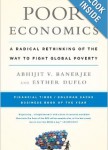Poor Economics: A Radical Rethinking of the Way to Fight Global Poverty

|
Title | Poor Economics: A Radical Rethinking of the Way to Fight Global Poverty |
| Author | Abhijit Banerjee and Esther Duflo | |
| Reviewer | Tate Watkins | |
| Review Date | November 01, 2013 | |
| Publisher | Public Affairs | |
| Year | 2011 | |
| Rate this Book |
“It is curious how people take it for granted,” George Orwell wrote in 1933, “that they have a right to preach at you and pray over you as soon as your income falls below a certain level.” Orwell was writing in Down and Out in Paris and London, his memoir about time spent as a fledgling writer and drifter who washed dishes in Parisian hotel kitchens and later frequented London tramp houses.
Nearly a century later, too many people are still wont to assume the same rights. In Poor Economics, MIT development economists Abhijit Banerjee and Esther Duflo spurn the temptation. Rather than preaching at or praying over the poor, Banerjee and Duflo attempt “to knit together a coherent story of how poor people live their lives” (ix). The book, named the Financial Times and Goldman Sachs Business Book of the Year for 2011, uses almost a decade of research and conversations with poor people around the globe to tell this story.
Banerjee and Duflo founded the Abul Latif Jameel Poverty Action Lab (J-PAL) in 2003 to test questions about poverty alleviation using randomized control trials—the same type of experiments used in clinical trials to test potential pharmaceuticals. In one J-PAL experiment, they offered inexpensive two-pound bags of beans to mothers who brought their children to specific locations for immunizations. The result was a sevenfold increase in immunization rates compared with sites that did not offer the meager reward to parents.
The authors lament that most development economists and foreign aid wonks focus on sweeping questions of whether or how much aid “works”—to spur economic growth, for instance. “Instead of discussing how best to fight diarrhea or dengue,” they write, “many of the most vocal experts tend to be fixated on the ‘big questions’” (3). Banerjee and Duflo, by contrast, fix their attention on using small scale interventions to find whether and how projects work in a certain time and place. By shying from universal declarations about foreign aid they’re able to document the far-reaching implications successes on a small scale can have, for example, that a deworming treatment in Kenya that cost $1.36 per year could increase school attendance and lead to a lifetime gain in income of $3,269 per student (39).
In addition to hundreds of empirical trials and results, the authors embark on something that economists do only too rarely: talk to their subjects. The researchers’ experiments by nature involve knocking on doors and speaking to people. In doing so, they learn things that desk-bound economists never would.
Take Oucha Mbarbk. Mbarbk lives in a remote Moroccan village, and when Banerjee and Duflo asked him what he would do with more money, he told them that he would buy more food. If he had even more money, he said he would buy better-tasting food. The economists pitied the plight of Mbarbk and his family until they walked into his house, where they noticed a TV, parabolic antenna, and DVD player. When asked why he bought electronic gadgets if his family didn’t have enough to eat, Mbarbk responded, “Oh, but television is more important than food” (36)!
The exchange reminded me of Yacine, one of my host family sisters when I lived in Senegal during my post-college Peace Corps stint. My host family and I routinely ate bland rice and unappetizing fish with few if any vegetables. One day Yacine returned from a trip to a market just across the border in Mauritania and set a large box on the floor in front of me. It contained an 18-inch color TV that—in a house with no electricity—we could only watch for a couple of hours each night on a car battery that had charged during the day via an old solar panel.
In painting pictures of quotidian life for the world’s poor, Poor Economics shows that they are prone to short-term thinking and cognitive biases—just as all humans are. “[T]he poor are no less rational than anyone else—quite the contrary,” write the authors. “Precisely because they have so little, we often find them putting much more careful thought into their choices …” (ix). Who’s to say that television isn’t more important than vegetables?
In Udaipur, India, the authors found that the typical poor household could spend 30 percent more on food if they cut purchases of alcohol, tobacco, and festivals-spending (23). But they do not. Similarly, when the poor can buy more food, they often buy not more calories but more appetizing calories. Banerjee and Duflo do not interpret this behavior as evidence that poor people are fundamentally different from others. After all, the upper crust can be just as self-indulgent as down-and-outs when weighing trade-offs between long-term interests and short-term tastes—or broccoli and beer. The researchers instead provide evidence that helps explain why the poor often don’t act as faraway experts may predict or even nudge them to do.
The rigorous results from the economists’ experiments, even if only applicable to a particular time and place, contrast with many ambitious aid programs that claim to be able to end poverty but provide little more than theories. Yet the limits to what randomized control trials can reveal are salient. Harvard development economist Lant Pritchett has noted of randomized control trials: “many, if not most, of the consequential questions of development economics are simply not susceptible to this approach. No formal method—from the use of calculus to general equilibrium to simulations to controlled experiments to ‘field’ experiments—tells us which are the important questions.” We still do not know exactly why some economies grow fast out of seemingly nowhere while others descend from sustained growth into chaos, a point that Banerjee and Duflo cite as motivation for the sort of small-slice studies they do. But the danger, in Pritchett’s eyes, is the potential to chase “precise answers to trivial questions.”
Nevertheless, the approach is attracting attention. Charles Kenny, senior fellow at the Center for Global Development, notes that the benefit from such research “is orders of magnitude higher than yet another statistical study in the ongoing and seemingly eternal debate over the evidence of a link between aid and economic growth.” At least randomized control trials provide an “obvious and equivocal answer to the question over such a link: ‘It depends’” (http://www.democracyjournal.org/22/small-change.php?page=all ).
J-PAL’s premise is that by using knowledge gleaned from empirical tests, small steps can make significant progress toward poverty alleviation. But, as Banerjee and Duflo point out, “It is not how policy usually gets made” (15). As they note themselves, there are many problems with trying to scale-up results from a small intervention in one rural village to regional or national levels, let alone wide-reaching policies. Local context and knowledge will always affect the results of a randomized control trial and, more so, messier and less controllable philanthropic interventions. Experimental findings in one village or a set of sites may be suggestive, but may also provide little more than insights into what might work somewhere else.
In championing marginal change, Banerjee and Duflo argue that poverty alleviation is not only possible but also worthwhile. A duty to help the poor underpins their motivation—in the acknowledgements, they cite “an unwillingness to live with the injustice” (275) of the world as a strong influence on their work. But it’s a short leap from duty to help with dignity to paternalism.
In a chapter on health policy, the authors note that many people, even in rich countries, are not willing to invest in even cheap preventative medicine. But, they write, denizens of the rich world have “invisible nudges”—things like mandatory immunization for children who attend public schools and rewards from insurance companies for joining a gym—that push them toward optimal strategies. After pages of stumping for technocratic health policies in the developing world, they concede, “All this sounds paternalistic, and in a way, it certainly is” (69).
“The main danger with RCTs,” writes George Mason University economist Tyler Cowen,” is that, in development economics, they will lead to an excess focus on social engineering as a driver of development” (http://marginalrevolution.com/marginalrevolution/2010/05/how-good-are-rcts.html ). Even as the authors emphasize the narrow over the sweeping, it’s easy to see a policymaker’s temptation to tout the apparently hard-and-fast findings from randomized control trials as support for his pet policy.
Still, Banerjee and Duflo’s most valuable contribution is to shift conversation from the intractable problem of “global poverty” toward a focus on manageable slices of the issue. Their work suggests that private “searchers”—like local businesses and organizations, or economists who venture out from behind their desks—who seek solutions to small problems from the ground up may be better suited than policymakers to address these slices of the poverty problem. At the very least, policymakers could attend better to the discoveries of these helping hands on the ground.
“If giving lentils works in India but not Uganda,” says Cowen, “that’s worth knowing, and how else are we to obtain that knowledge” (http://marginalrevolution.com/marginalrevolution/2010/05/how-good-are-rcts.html )? The real world tests promoted by Banerjee and Duflo are a fruitful endeavor toward obtaining such knowledge and using it to foster improvements, even if “only” at the margin.
Tate Watkins is a freelance journalist in Port-au-Prince, Haiti, where he writes about economic development, foreign aid, and immigration. His work has appeared in a variety of outlets, including Reason magazine, Quartz, Wired.com, and The American Interest. Watkins grew up in Nashville, TN, received M.A. and B.A. degrees in economics from Clemson University, and lived in rural Senegal for a year while in the Peace Corps. He also spent two years researching economics and public policy in Washington, D.C.




